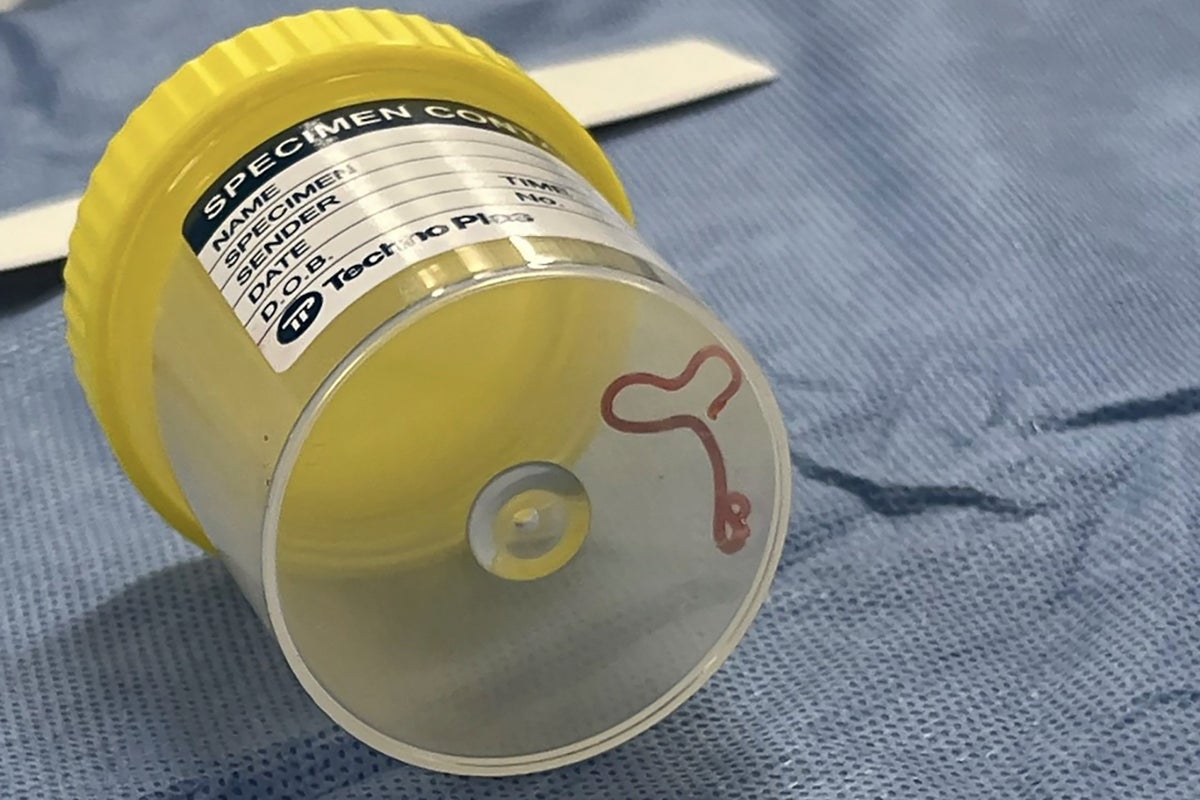
A live, 8cm-long (3in) worm has been removed from the brain of a 64-year-old Australian woman by a neurosurgeon investigating the patient’s mystery symptoms.
The surgeon, Hari Priya Bandi, was operating on the woman’s skull when she discovered the parasite still alive – thought to be a world-first.
“I just thought: ‘What is that? It doesn’t make any sense. But it’s alive and moving,’” Dr Bandi was quoted by local media. She ended up plucking the worm out with forceps. “It continued to move with vigour. We all felt a bit sick.”
The roundworm – Ophidascaris robertsi – was still “wriggling”, according to a study of the case just published in the journal Emerging Infectious Diseases, following the operation last year. It was the larva of the Australian-native species, not previously known to be a human parasite.
Dr Brandi co-wrote the case study with Sanjaya Senanayake, an infectious diseases physician at Canberra Hospital. Dr Senanayake said he was on duty at the hospital in June last year when the worm was found.
“I got a call saying: ‘We’ve got a patient with an infection problem. We’ve just removed a live worm from this patient’s brain,’” Dr Senanayake said. “This is the first-ever human case of Ophidascaris to be described in the world”.
Doctors said the woman’s symptoms first started in January 2021. She first developed abdominal pain and diarrhoea, “followed by fever, cough and shortness of breath”.
The patient was first admitted to a local hospital in late January 2021 after suffering three weeks of abdominal pain and diarrhoea, followed by a constant dry cough, fever and night sweats.
They said these symptoms were likely due to the migration of roundworm larvae from the bowel and into other organs such as the liver and the lungs.
When respiratory samples and a lung biopsy were performed, no parasites were identified in these tissue specimens.
“At that time, trying to identify the microscopic larvae, which had never previously been identified as causing human infection, was a bit like trying to find a needle in a haystack,” said Karina Kennedy, another author of the study from Canberra Hospital.
By 2022, doctors said the patient was experiencing forgetfulness and depression, prompting an MRI scan that showed an atypical tissue injury within the right frontal lobe of the brain.
Dr Senanayake said the brain biopsy was expected to reveal a cancer or an abscess.
"This patient had been treated ... for what was a mystery illness that we thought ultimately was an immunological condition because we hadn’t been able to find a parasite before and then out of nowhere, this big lump appeared in the frontal part of her brain,” the physician said.
“Suddenly, with [Dr Bandi’s] forceps, she’s picking up this thing that’s wriggling. She and everyone in that operating theatre were absolutely stunned,” Dr Senanayake added.
Dr Bandi said her patient regained consciousness after the worm was successfully extracted. “She was so grateful to have an answer for what had been causing her trouble for so very long.”
Six months after the worm was removed, the patient’s neuropsychiatric symptoms had improved but persisted, the journal article said.
The patient had been sent home soon after the surgery with antiparasitic drugs and had not returned to hospital since, Dr Senanayake said. “She’s done OK, but obviously because this is a new infection, we're keeping a close eye on her,” the doctor told Ten Network television.
Detection of ‘Ophidascaris robertsi’ nematode infection in a 64-year-old woman from southeastern New South Wales, Australia— (Emerging Infectious Diseases)
This worm is usually commonly found in carpet pythons. Its larvae are usually found in small mammals and marsupials, which are then eaten by the python, allowing the life cycle to complete itself in the snake.
Researchers said the worm typically lives in a python’s oesophagus and stomach and sheds its eggs in the host’s faeces. Humans would be considered accidental hosts of Ophidascaris robertsi larvae, they said.
The patient, from southeastern New South Wales, likely caught the roundworm after collecting a type of native grass, called Warrigal greens, beside a lake near where she lived.
This is where a python may have likely shed the parasite through its faeces.
In the new case study, researchers said the woman used Warrigal greens for cooking and was likely infected with the parasite from touching the native grass or after eating the greens.
Roundworms are known to be resilient and capable of thriving in a wide range of environments.
They are known to cause stomach pain, vomiting, diarrhoea, appetite and weight loss, fever, and tiredness in humans.
Researchers cautioned that the case highlights the danger of diseases and infections passing from animals to humans in a world where the habitats have increasingly come to overlap with each other.
“There have been about 30 new infections in the world in the last 30 years. Of the emerging infections globally, about 75 per cent are zoonotic, meaning there has been transmission from the animal world to the human world. This includes coronaviruses,” Dr Senanayake said.
“People who garden or forage for food should wash their hands after gardening and touching foraged products,” Dr Kennedy said.
“Any food used for salads or cooking should also be thoroughly washed, and kitchen surfaces and cutting boards, wiped downed and cleaned after use.”
Associated Press contributed to this report







